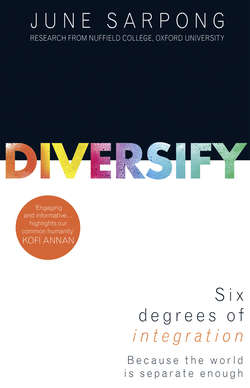Читать книгу Diversify: A fierce, accessible, empowering guide to why a more open society means a more successful one - June Sarpong, June Sarpong - Страница 19
ОглавлениеCHAPTER TWO
In the Media
‘You can’t be what you can’t see.’
Marian Wright Edelman
Throughout the ages, from paintings through to magazine covers and the movies, society’s beauty standards have been represented via images that have been heralded as the ‘ideal’ of the day. Women in particular have been subjected to this relentless objectification and anyone falling short of these standards is either denigrated or ignored, leaving millions of young girls and women feeling unworthy, unrepresented, and fearful of rejection. Women are held to an entirely different set of standards than their male counterparts – we are valued by the way we look and how young we are; the ‘prettier’ and younger the better – and the mental pressure this creates wreaks havoc on our self-esteem. As a result, women are plagued with a level of self-doubt and self-criticism (myself included) that men do not have to face. And it’s led to a narrow representation of women, not just in the visible media but behind the scenes as well.
As someone who has worked in the media for almost 20 years, I am very much aware of the power of image and the impact it has on how we value ourselves. I’ve even experienced its discriminating effects first-hand. So now, with ordinary women drastically under-represented, with actresses frequently flagging up the gender pay gap in the film industry, the proliferation of misogynistic trolling on social media and the easy access to online porn, it’s become blindingly obvious that unrealistic, unrepresentative, and sometimes unhealthy images of women are projected into people’s homes and minds on a daily basis. To counter this, we clearly need our media to start involving and portraying women in a more balanced and affirming manner.
Leading ladies
The Oscar-winning actress Geena Davis has become a leading advocate for the better representation of women in the media: her Institute on Gender in Media is doing a stellar job of holding Hollywood accountable by monitoring the representation of women both in front of and behind the camera.
I was fortunate enough to discuss this issue in detail with Geena when she delivered the keynote address at the WIE New York 2012 that I helped to organize, and some of the data from her research is quite startling.
• Only 16% of protagonists in film are female.
• Only 7% of film directors and 10% of writers are female.
• There were only 13 female protagonists in animated movies between 1937 and 2005.
• The female characters in G-rated family movies are just as likely to wear revealing clothing as in R-rated (effectively 18-rated) movies.
• More than 70% of the women on TV are in their twenties and thirties.*
The Institute’s findings point to a systemic problem at the very core of the industry: the decision makers in the commissioning meetings, and maybe even the writers and directors themselves, are unwilling to put women at the heart of their stories. Geena is very frank about the problem: ‘All of Hollywood is run on one assumption: that women will watch stories about men, but men won’t watch stories about women. It is a horrible indictment of our society if we assume that one half of our population is just not interested in the other half.’
In some ways, we are trapped in a vicious circle here. Boys see from early on that male superheroes have a wide range of abilities, but the female’s superpower will primarily be that she looks good in a tight outfit. That may well be nice to look at, but it can’t be called interesting. In a world where women on screen are idolized primarily for their appearance and rarely given stories of much depth or complexity, it’s no wonder that it’s been hardwired into all of society that women are not interesting to men.
